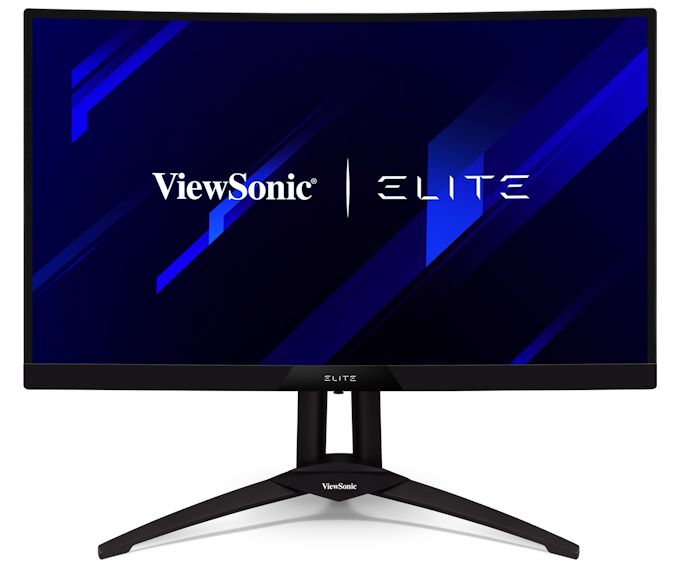ViewSonic Announces Elite XG270QC Monitor: 1440p@165 Hz, Curved For Gaming
by Gavin Bonshor on May 22, 2020 2:00 PM EST
The latest monitor in Viewsonic's large and varied portfolio comes via the XG270QC, which is a part of its gaming-focused Elite series. Available in the US now, the 27 inch Viewsonic Elite XG270QC features a 1500R curved screen, with a refresh rate of 165 Hz, and is certified for VESA DisplayHDR 400.
Designed with gaming in mind, the Viewsonic Elite XG270QC comes with many of the features you'd expect for a contemporary gaming displaying. including a 27-inch, 2560x1440 VA panel with a fast refresh rate of 165 Hz, variable refresh support including AMD's FreeSync Premium Pro certification, and is VESA certified DisplayHDR 400. Although officially it has a 3 ms response time, Viewsonic is stating that it has a 1 ms MPRT response time, with Viewsonic's PureXP Motion Blur reduction technology making this possible. The curve of the panel is rated at 1500R which Viewsonic claims is provide a more immersive gaming experience.
Looking at the dimensions, it's 24.1 inches wide with a 4-inch depth. It has an adjustable height of between 18.97 and 23.59 inches, with a net weight of 7.5 kg with the stand installed. For users looking to mount it to a monitor stand or wall mount, it is VESA 100 x 100 mm mounting on the rear and weighs 4.9 kg without the stand installed. The XG270QC has a black glossy finish and includes a single DisplayPort 1.4 input, two HDMI 2.0 inputs, a 3.5 mm audio output, and for security, it features a Kensington Lock slot. Provided with the Elite XG270QC is Viewsonic's Elite Display Controller software which connects to its device via a Type-A cable which is supplied, and allows users to adjust the integrated RGB LED lighting. It is certified to work with ThermalTake's RGB Plus and Razer's popular Chroma RGB Ecosystems.
Touching on some of the finer details of the 27-inch panel, it has a 178-degree viewing angle and offers VESA Adaptive-Sync support. It features AMD FreeSync Premium Pro certification, which is AMD's own classification system for grading monitors, ensuring among other things a wide enough refresh rate for Low Framerate Compensation support, as well as low-latency HDR support. In terms of color reproduction, Viewsonic is claiming 16.7 million colours, with a 3,000 to 1 static contrast ratio and 120 million to 1 dynamic contrast ratio. For power, Viewsonic states that in Eco mode, it's optimized for 45 W, while it has a 55 W typical consumption rate, with a maximum of up to 59 W.
Viewsonic has said that the Elite XG270QC is to purchase in the US for a price around the $460 mark. Users in the EU, AU, and other regions around the world will, however, need to wait until June.
Related Reading
- ASUS Launches ROG Strix XG27WQ Curved 165Hz Monitor: FreeSync Premium Pro Certified
- I Need Speed: MSI Reveals Optix MAG251RX 240Hz IPS Gaming Monitor
- Samsung to Cease Traditional LCD Production, Move to Quantum Dot OLEDs
- TUF Goes FreeSync Premium: ASUS TUF Gaming VG27VHIB 27-Inch 165Hz DCI-P3 Monitor
Source: Viewsonic











38 Comments
View All Comments
CrimsonKnight - Tuesday, May 26, 2020 - link
It's an official VESA spec. It's good because it lets you know exactly what you're getting. The fact that you see it and immediately know the monitor isn't good enough for you means it's working as intended.Pyrostemplar - Sunday, May 24, 2020 - link
well, going a biy off topic, I'd prefer a 21:10, HDR1000, 42ish", 1800R 120hz HDMI 2.1 OLED monitor under 1.3K USD :)Thud2 - Sunday, May 24, 2020 - link
Not possessing a deep understanding of the underlying tech, why 165 Hz? I know 24Hz is old school film, then it went to 30 for digital then 60 but how did they settle on 165Hz for this monitor?jabber - Monday, May 25, 2020 - link
I saw a test on YouTube and the guys were testing 60/75/120/165Hz etc. most struggled to tell the difference from 75Hz+ so i think a lot of it is BS. 80Hz would probably do for most people.Obviously there are the golden eyed out there...
flyingpants265 - Monday, May 25, 2020 - link
You didn't watch the right video, then. It's not even close to BS.inighthawki - Monday, May 25, 2020 - link
Linus Tech Tips did a video and showed that people noticed the difference all the way up to 240hz. The gains had diminishing returns, of course, but they could absolutely tell the difference. You don't need to possess superhuman eyesight to tell the difference, you just need to use it in the right scenarios to see the difference.Dug - Tuesday, May 26, 2020 - link
You need to look at other tests. As far as gaming, lower than 120hz is a game breaker for fast shooters. Most will fail at simple test of not moving and shooting at object going across screen. At higher refresh rates, no problem.It's more to do with the entire pipeline latency, not just what you view on screen. nvidia has explained it very well.
PeachNCream - Monday, May 25, 2020 - link
I used to get excited about Sony Trinitron screens for video games, but I quickly grew out of that phase when I realized there was a lot of money to throw away just to make a marginal difference. Now I get whatever comes with the laptop I buy second hand from eBay, pocket the extra money saved by sliding it into an emergency fund or investment account, and get on with more important aspects of life.Dug - Tuesday, May 26, 2020 - link
There's nothing more important in life than displays.star-affinity - Saturday, May 30, 2020 - link
@Dug😆